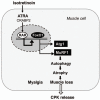Isotretinoin and FoxO1: A scientific hypothesis
- PMID: 22110774
- PMCID: PMC3219165
- DOI: 10.4161/derm.3.3.15331
Isotretinoin and FoxO1: A scientific hypothesis
Abstract
Oral isotretinoin (13-cis retinoic acid) is the most effective drug in the treatment of acne and restores all major pathogenetic factors of acne vulgaris. isotretinoin is regarded as a prodrug which after isomerizisation to all-trans-retinoic acid (ATRA) induces apoptosis in cells cultured from human sebaceous glands, meibomian glands, neuroblastoma cells, hypothalamic cells, hippocampus cells, Dalton's lymphoma ascites cells, B16F-10 melanoma cells, and neuronal crest cells and others. By means of translational research this paper provides substantial indirect evidence for isotretinoin's mode of action by upregulation of forkhead box class O (FoxO) transcription factors. FoxOs play a pivotal role in the regulation of androgen receptor transactivation, insulin/insulin like growth factor-1 (IGF-1)-signaling, peroxisome proliferator-activated receptor-γ (PPArγ)- and liver X receptor-α (LXrα)-mediated lipogenesis, β-catenin signaling, cell proliferation, apoptosis, reactive oxygene homeostasis, innate and acquired immunity, stem cell homeostasis, as well as anti-cancer effects. An accumulating body of evidence suggests that the therapeutic, adverse, teratogenic and chemopreventive effecs of isotretinoin are all mediated by upregulation of FoxO-mediated gene transcription. These FoxO-driven transcriptional changes of the second response of retinoic acid receptor (RAR)-mediated signaling counterbalance gene expression of acne due to increased growth factor signaling with downregulated nuclear FoxO proteins. The proposed isotretinoin→ATRA→RAR→FoxO interaction offers intriguing new insights into the mode of isotretinoin action and explains most therapeutic, adverse and teratogenic effects of isotretinoin in the treatment of acne by a common mode of FoxO-mediated transcriptional regulation.
Keywords: FoxO; acne; apoptosis; isotretinoin; stem cell; transcriptional regulation.
Figures








References
-
- Peck GL, Olsen TG, Yoder FM, Strauss JS, Downing DT, Pandya M, et al. Prolonged remissions of cystic acne with 13-cis-retinoic acid. N Engl J Med. 1979;300:329–333. - PubMed
-
- Ganceviciene R, Zouboulis CC. Isotretinoin: state of the art treatment for acne vulgaris. Expert Rev Dermatol. 2007;2:693–701. - PubMed
-
- David M, Hodak E, Lowe NJ. Adverse effects of retinoids. Med Toxicol Adverse Drug Exp. 1988;3:273–288. - PubMed
-
- Tsukada M, Schröder M, Roos TC, Chandraratna RA, Reichert U, Merk HF, et al. 13-cis retinoic acid exerts its specific activity on human sebocytes through selective intracellular isomerization to all-trans retinoic acid and binding to retinoid acid receptors. J Invest Dermatol. 2000;115:321–327. - PubMed
LinkOut - more resources
Full Text Sources
Research Materials
Miscellaneous
